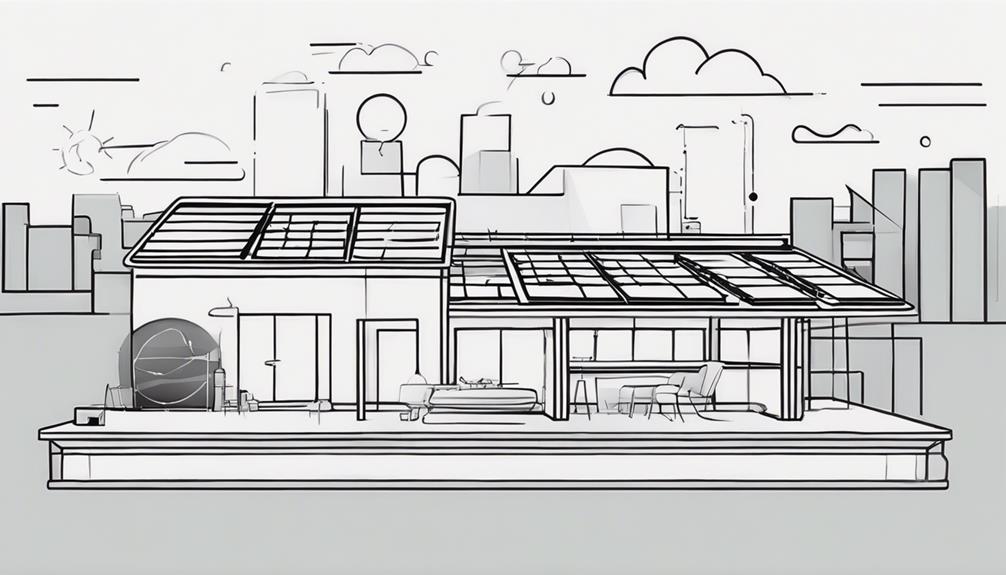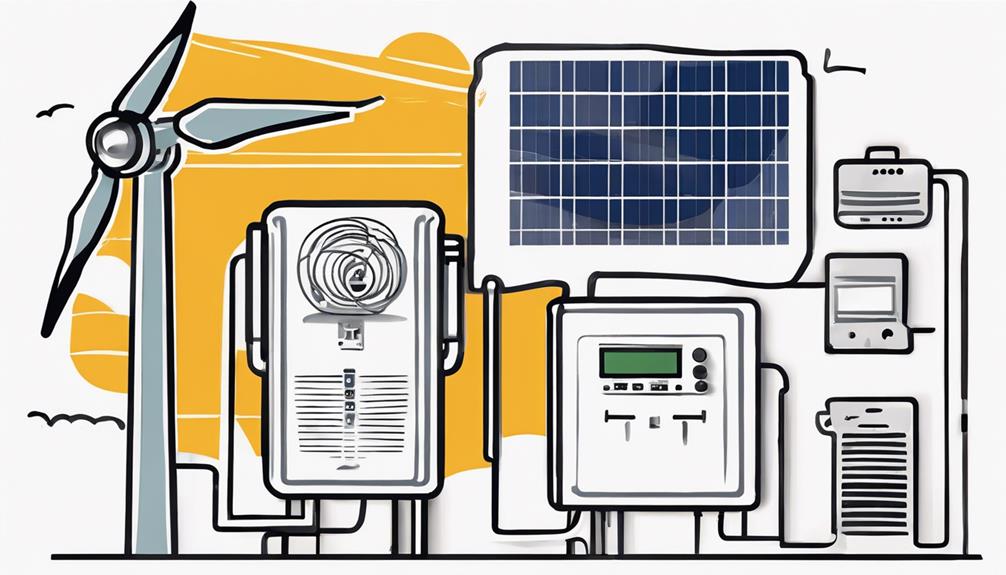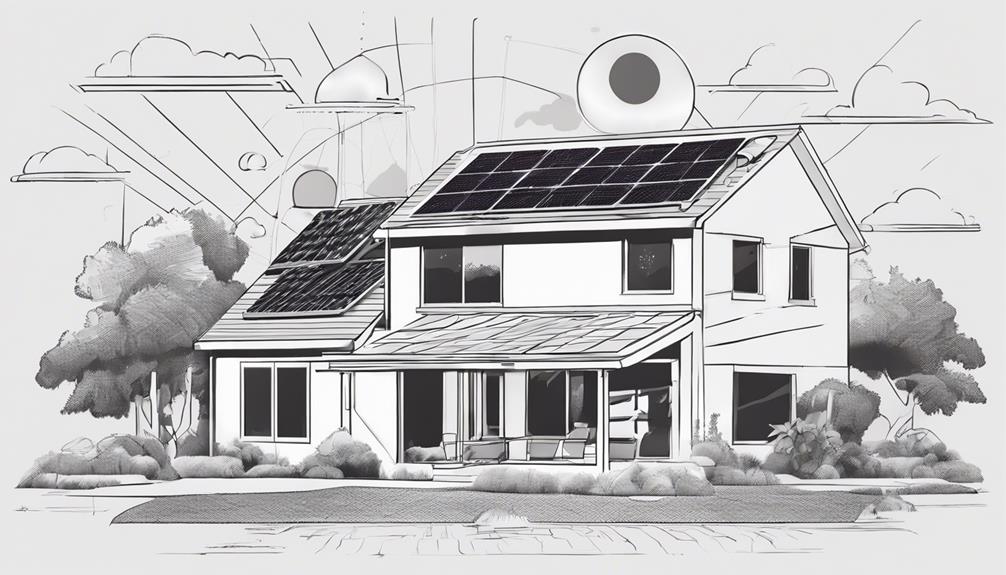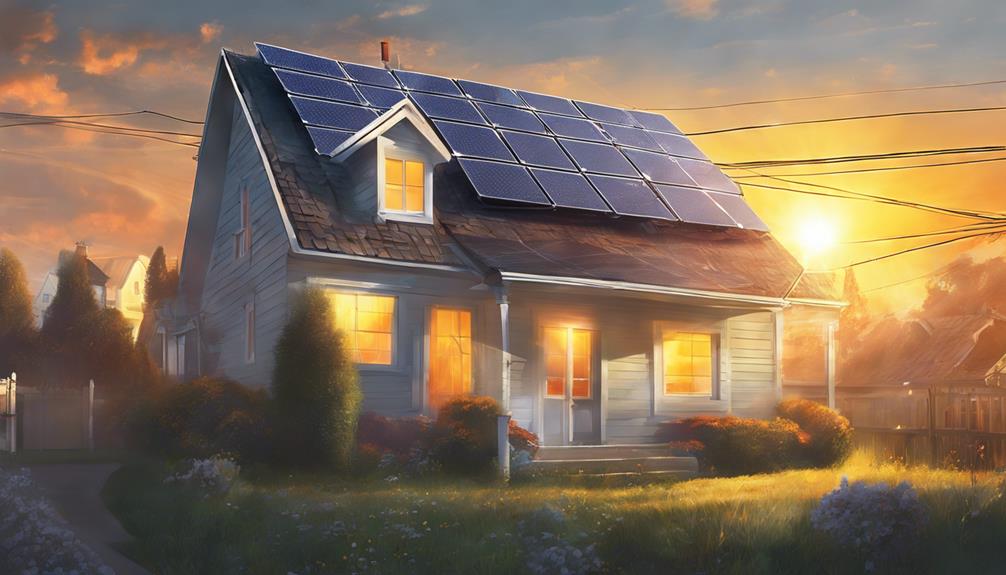Solar panels harness the power of sunlight through a complex interplay of materials and physics, ultimately converting photons into usable electricity. The intricate design of photovoltaic cells and their ability to create an electric field from sunlight is at the core of this process. Understanding the mechanism behind this renewable energy source sheds light on its significance in our quest for sustainable power generation. But how exactly do these seemingly simple panels manage to capture and convert solar energy with such efficiency? The answer lies in the fundamental principles of solar technology, offering a glimpse into the future of clean energy solutions.
Key Takeaways
- Solar panels harness sunlight through photovoltaic cells for electricity generation.
- Photovoltaic cells convert sunlight into direct current (DC) electricity.
- Solar inverters transform DC electricity into usable alternating current (AC).
- Proper panel orientation, maintenance, and quality ensure optimal solar energy efficiency.
Solar Energy Basics

Solar energy, harnessed through the conversion of sunlight into electricity by solar panels, forms the fundamental basis of solar energy basics. Solar power is derived from the sun's radiation, which contains photons that activate the solar cells within panels. These solar cells, often composed of silicon, facilitate the photovoltaic process by absorbing sunlight and generating an electric current. The photovoltaic effect allows solar panels to transform light energy into usable electrical power, providing a sustainable and renewable source of energy. By leveraging nuclear fusion reactions triggered by the sun's immense heat, solar panels play a crucial role in harvesting clean energy and reducing reliance on fossil fuels. Understanding the principles behind solar energy is essential for appreciating the significance of solar panels in the realm of renewable energy generation. Harnessing the power of sunlight through solar panels represents a key aspect of transitioning towards a more environmentally friendly and sustainable energy future.
Photovoltaic Cells Overview
Photovoltaic cells, crucial components of solar panels, play a fundamental role in converting sunlight into electricity. Understanding the cell structure is key to comprehending how these semiconductor materials harness solar energy to release electrons and generate an electric current. This energy conversion process is central to the functioning of solar panels, wherein multiple photovoltaic cells work in unison to produce usable electricity.
Cell Structure
Typically composed of semiconductor materials such as silicon, the cell structure of photovoltaic cells plays a crucial role in the generation of electricity from sunlight. These cells are designed to create an electric field within them by doping the silicon with specific materials. This electric field facilitates the separation of positive and negative charges within the cells. When photons from sunlight interact with the cells, they dislodge electrons, leading to the generation of an electric current. The electric current produced is then collected by metal conductive plates within the cells and transferred through wires for practical use as electricity. This process highlights the significance of the cell structure in enabling the conversion of solar energy into electrical power efficiently.
Electricity Generation
Within solar panels, the process of electricity generation through photovoltaic cells involves the absorption of sunlight to initiate the creation of an electric current.
Key Points:
- Photovoltaic cells in solar panels absorb sunlight, causing the photovoltaic effect.
- When sunlight hits the PV cells, photons knock electrons loose, generating electricity.
- The flow of electrons through the PV cells produces direct current (DC) electricity.
- Solar inverters convert DC electricity into alternating current (AC) for household use.
Solar panels generate electricity efficiently by harnessing the power of sunlight through this process. The conversion of sunlight into usable electricity provides a sustainable and renewable energy source for various applications.
Energy Conversion
The conversion of sunlight into electricity through the photovoltaic effect is a fundamental process within solar panels, driving the generation of electrical current in photovoltaic cells. Silicon solar cells, the most common type used in photovoltaics, absorb photons from sunlight, facilitating the creation of an electric current. This flow of electrons within the photovoltaic cells results in the production of direct current (DC) electricity. To make this electricity usable for homes and businesses, inverters are employed to convert the DC electricity from the solar panels into alternating current (AC). Solar panels efficiently harness solar energy by utilizing the photovoltaic process, making them a key player in sustainable electricity generation.
The Photovoltaic Effect Explained
In solar panels, the photovoltaic effect is the crucial mechanism responsible for transforming sunlight into electricity. Photovoltaic cells, typically made from silicon, play a key role in this process by absorbing photons from sunlight. Here is how the photovoltaic effect works:
- Absorption of Photons: Photovoltaic cells within solar panels absorb photons, which are particles of light energy from the sun.
- Electron Liberation: When photons strike the solar panel, they have enough energy to knock electrons loose from atoms within the silicon material.
- Generation of Electric Current: The liberation of electrons creates an electric current as the loose electrons move within the material.
- Electricity Production: This electric current generated by the photovoltaic effect is then harvested and used as electricity, providing a reliable source of clean and renewable energy.
Understanding the photovoltaic effect is essential in comprehending how solar panels can harness solar energy efficiently and convert it into usable electrical power.
Solar Inverters Function

Efficient utilization of solar energy relies significantly on the function of solar inverters, which play a critical role in converting the direct current (DC) electricity generated by solar panels into the alternating current (AC) electricity required for powering electronic devices in homes and businesses. Solar inverters ensure that the electricity produced by solar panels is compatible with the existing electrical grid infrastructure, allowing seamless integration. By converting DC to AC, these devices enable the efficient use of solar power, maximizing its usability. Moreover, solar inverters help manage the flow of electricity, optimizing energy utilization and ensuring smooth operation of the entire solar power system. The table below summarizes key points about solar inverters and their role in the conversion of electricity for practical use.
| Solar Inverters | DC Electricity | AC Electricity |
|---|---|---|
| Role | Conversion | Transformation |
| Function | DC to AC | AC to DC |
| Importance | Critical | Essential |
| Grid Compatibility | Yes | Yes |
| Energy Efficiency | Enhanced | Utilized |
Electricity Flow in Homes
Solar panels play a crucial role in powering household appliances by converting sunlight into electricity. Monitoring energy consumption becomes more manageable with solar panels, allowing homeowners to track their usage and make informed decisions. Additionally, solar panels can serve as a backup power source during outages, ensuring continuous electricity flow in homes.
Powering Household Appliances
Household appliances are powered by converting the direct current (DC) electricity generated by solar panels into alternating current (AC) using inverters. This conversion is essential for the appliances to function efficiently and effectively in homes. To illustrate the process clearly:
- Solar panels absorb sunlight and convert it into DC electricity through photovoltaic cells.
- Inverters transform the DC electricity into AC, which is the standard form of electricity used in households.
- The AC electricity powers various appliances such as refrigerators, lights, and electronics.
- Excess electricity produced by solar panels can be directed back into the power grid for credit or compensation, promoting energy efficiency and cost savings.
Energy Consumption Monitoring
Tracking the flow of electricity in residential settings, known as energy consumption monitoring, plays a crucial role in understanding and optimizing household energy usage. Smart meters and energy monitoring devices provide real-time data on electricity consumption, enabling homeowners to identify usage patterns and opportunities for efficiency improvements. By analyzing energy consumption data, informed decisions can be made regarding energy-saving measures and sustainable practices. Managing peak demand and optimizing energy use during off-peak hours are essential benefits of monitoring energy consumption. This proactive approach not only helps in reducing electricity bills but also contributes to a more sustainable energy future. Below is a table highlighting the key aspects of energy consumption monitoring:
| Aspect | Description |
|---|---|
| Real-time Data | Smart meters provide instant information on electricity consumption. |
| Efficiency Improvements | Monitoring helps identify areas where energy efficiency can be enhanced. |
| Peak Demand Management | Enables better management of peak electricity demand periods. |
| Cost Savings | Optimizing energy use leads to reduced electricity bills. |
| Sustainable Practices | Supports the adoption of energy-saving measures and sustainable habits. |
Backup During Outages
During power outages, the utilization of backup systems in residential settings ensures a continuous flow of electricity for essential household functions. Solar panels play a crucial role in providing backup electricity by storing excess energy in solar batteries. Solar inverters are essential for converting the direct current (DC) electricity generated by solar panels into alternating current (AC) electricity, making it suitable for powering household appliances during outages. Excess energy produced by solar panels can be either stored in batteries for later use when sunlight is not available or fed back into the grid. These backup systems, such as solar batteries, enhance energy resilience by ensuring a steady power supply in homes even when the main grid is down.
Excess Electricity Handling
Excess electricity generated by solar panels can be efficiently managed through various methods to optimize its utilization and minimize reliance on traditional grid systems. Grid-tied solar systems offer a practical solution by allowing surplus electricity to be fed back into the grid. This process enables users to earn credits or compensation for the excess power they contribute. Net metering programs further enhance this by enabling homeowners to offset their electricity bills by exporting their surplus solar power. Additionally, Power Purchase Agreements (PPAs) provide an avenue for selling excess solar electricity to utility companies, fostering a more sustainable energy ecosystem.
Furthermore, energy management systems play a crucial role in handling excess electricity by optimizing its utilization within a home or building. These systems ensure that surplus solar power is efficiently used to meet the property's energy needs, reducing dependence on the grid and maximizing the benefits of solar energy generation. By incorporating these methods, individuals and businesses can effectively manage the excess electricity produced by solar panels, contributing to a more efficient and sustainable energy environment.
Alternative Solar Technologies

Harnessing innovative advancements in solar technology, alternative solar technologies present compelling options for enhancing energy generation efficiency and sustainability. These technologies offer unique advantages and show great promise in the field of solar energy. Here are four alternative solar technologies that are making significant strides:
- Organic Solar Cells: Utilizing organic materials to convert sunlight into electricity, organic solar cells provide a lightweight and potentially cost-effective alternative to traditional solar panels.
- Perovskite Solar Cells: Known for their high efficiency and ease of manufacture, perovskite solar cells have emerged as a promising technology for solar energy generation.
- Dye-Sensitized Solar Cells: By using dyes to absorb sunlight and convert it into electricity, dye-sensitized solar cells offer versatility in design and application, opening up new possibilities for solar panel integration.
- Quantum Dot Solar Cells: Quantum dot solar cells are an emerging technology with the potential for high efficiency and tunable light absorption properties, contributing to advancements in solar energy conversion.
Solar Hot Water Systems
Solar hot water systems efficiently utilize solar collectors to harness sunlight and heat water for various domestic purposes. These systems are equipped with solar thermal panels that capture solar energy to directly heat water. By utilizing renewable energy sources, solar hot water systems offer an energy-efficient and environmentally friendly way to heat water for activities such as showers, baths, and household heating. Compared to traditional water heating methods, solar hot water systems can lead to significant energy savings and help reduce carbon emissions.
The technology behind solar hot water systems is relatively simple yet effective. Solar collectors absorb sunlight and convert it into heat, which is then transferred to the water passing through them. This heated water is stored in a tank for later use, ensuring a steady supply of hot water whenever needed. Overall, solar hot water systems represent a sustainable and viable option for those looking to reduce their environmental impact and energy consumption in a cost-effective manner.
Concentrated Solar Power

Utilizing reflective mirrors to concentrate sunlight onto receivers, Concentrated Solar Power (CSP) systems efficiently generate high temperatures for electricity production, making them a prominent technology in renewable energy applications. Here are four key aspects of Concentrated Solar Power technology:
- High Temperature Generation: CSP systems can achieve remarkably high temperatures, reaching up to 1000 degrees Fahrenheit in the solar receiver. This high temperature is crucial for efficient electricity production through solar thermal processes.
- Thermal Energy Storage: CSP plants incorporate thermal energy storage systems to store excess heat generated during peak sunlight hours. This stored thermal energy can then be utilized for electricity generation during periods of low sunlight or at night, ensuring a consistent power supply.
- Efficient Conversion: CSP systems, such as power towers and parabolic troughs, are highly efficient in converting solar energy into electricity. The focused sunlight heats a fluid within the receivers, which then drives a turbine to produce electricity.
- Scalability and Utility: CSP technology is scalable and commonly deployed in utility-scale power plants for large-scale electricity generation. Its ability to store thermal energy makes it a reliable source of power, contributing to the stability of the grid.
Solar Panel FAQs
When considering solar panels, understanding their efficiency, installation process, and maintenance requirements is crucial. Solar panel efficiency determines how well the panels can convert sunlight into electricity, while installation involves positioning the panels for optimal sunlight exposure. Additionally, regular maintenance ensures the longevity and effectiveness of solar panels in generating clean energy.
Solar Panel Efficiency
Efficiency in solar panels is a critical metric that quantifies the effectiveness of converting sunlight into electricity. To optimize efficiency, consider panel orientation, shading, maintenance, and quality. Here are key points to enhance solar panel efficiency:
- Panel Orientation: Properly aligning panels to face the sun maximizes energy absorption.
- Shading: Avoid shading from trees, buildings, or other obstructions to ensure consistent sunlight exposure.
- Maintenance: Regular cleaning and inspection of panels help prevent efficiency losses due to dirt or damage.
- High-Quality Panels: Investing in quality panels with higher efficiency ratings, between 15-23%, can significantly improve overall energy production.
Solar Panel Installation
To ensure optimal performance and efficient energy production, solar panel installation involves strategically positioning and connecting panels to harness sunlight effectively. Solar panels are typically mounted on rooftops or ground-mounted systems, with their orientation and tilt angles carefully adjusted to maximize sunlight capture. These panels are connected in arrays to generate sufficient electricity for residential or commercial use. An essential component of solar panel installations is the inverter, which converts the direct current (DC) generated by the panels into usable alternating current (AC) for powering appliances. Proper wiring, grounding, and adherence to safety measures are crucial in solar panel installations to ensure optimal functionality and compliance with regulations.
| Solar Panel Installation | ||
|---|---|---|
| Mounting panels effectively | Orienting panels correctly | Connecting panels in arrays |
| Using inverters to convert electricity | Ensuring proper wiring and grounding |
Solar Panel Maintenance
For effective operation and longevity of solar panel systems, understanding common maintenance practices and frequently asked questions (FAQs) regarding solar panels is essential. Here are four important maintenance practices for keeping your solar panels in optimal condition:
- Regular Cleaning: Solar panels require minimal maintenance, usually just needing cleaning with water and a mild detergent to remove dirt and debris.
- Inspection: Regularly inspecting solar panels for damage, shading, or obstructions ensures optimal performance and efficiency.
- Monitoring: Check the inverter and monitor energy production to identify any issues with the solar panel system.
- Connection Maintenance: Maintaining proper connections and wiring in the solar panel system is crucial for safe and effective operation.
Going Solar With Confidence
With a comprehensive understanding of how solar panels harness sunlight to generate electricity, individuals can confidently transition to utilizing this renewable energy source. Solar panels work by utilizing the photovoltaic effect, where photons from the sun interact with solar cells to create an electric current. This process involves knocking electrons free from atoms within the solar cells, resulting in the flow of electrons that generates an electric charge usable as electricity. According to the Department of Energy, solar panels are instrumental in converting solar energy into electricity for various applications. To emphasize the benefits of going solar, consider the following table:
| Advantages of Going Solar | Description | Benefits |
|---|---|---|
| Cost-effective | Initial investment, long-term savings | Reduced electricity bills |
| Environmental impact | Clean energy source | Lower carbon footprint |
| Energy independence | Reduced reliance on grid | Increased self-sufficiency |
| Renewable resource | Abundant sunlight availability | Sustainable energy generation |
| Government incentives | Tax credits, rebates | Financial savings |
Frequently Asked Questions
How Do Solar Panels Work Step by Step?
Solar panel efficiency is optimized through proper installation and regular maintenance. Installation involves positioning panels to maximize sunlight absorption. Efficient solar panel technology utilizes high-quality materials and advanced design for improved performance. Routine maintenance, including cleaning and inspection, ensures optimal functionality. By following these steps diligently, solar panels can operate at peak efficiency, harnessing sunlight to generate electricity sustainably and reliably.
How Does Solar Work for Dummies?
Solar energy, in simple terms, involves harnessing sunlight to generate electricity. This process, known as photovoltaics, captures solar radiation and converts it into usable electrical power. Through the use of solar panels, the photovoltaic cells within them absorb sunlight, creating an electric current. This basic explanation provides a simplified breakdown for beginners, making solar power accessible even to those new to the field.
How Does Solar Panel Work in Simple Words?
Harnessing the power of the sun, solar panels convert sunlight into electricity through the photovoltaic effect. By capturing photons and freeing electrons within silicon cells, an electric current is generated. This current is then transformed from direct current (DC) to alternating current (AC) for practical use in homes and businesses. Solar panels operate during daylight hours, offering renewable energy that can be utilized immediately or stored for later consumption, providing energy efficiency benefits and promoting sustainability.
How Many Solar Panels Does It Take to Power a House?
The number of solar panels required to power a house varies based on factors such as energy consumption, sunlight exposure, and panel efficiency. Typically, a standard American home may need 20-25 solar panels to meet its electricity demands. A 5kW solar system, approximately equivalent to 20 panels, can adequately power a typical household. Considerations like roof space availability, local solar irradiance levels, solar panel size, and wattage are crucial in determining the quantity of panels needed for residential energy production. Professional solar panel installation, efficient energy storage solutions, and regular maintenance are essential for optimal system performance.
Conclusion
In conclusion, solar panels operate like efficient energy converters, akin to a well-oiled machine seamlessly transforming sunlight into electricity. Understanding the fundamental principles of photovoltaic cells, the photovoltaic effect, solar inverters, and electricity flow in homes is essential for harnessing solar energy effectively. Embracing solar technology with confidence can lead to sustainable energy solutions and a brighter future for our planet.
